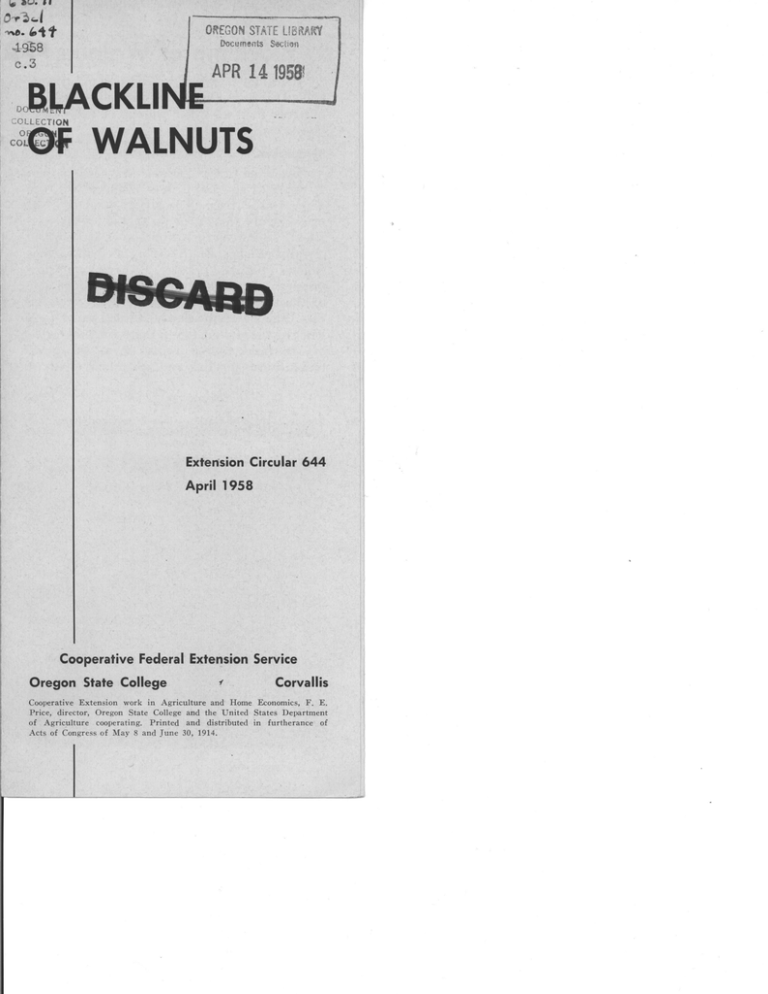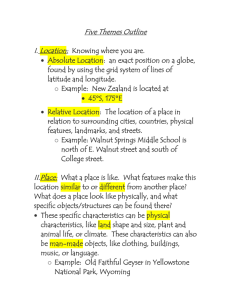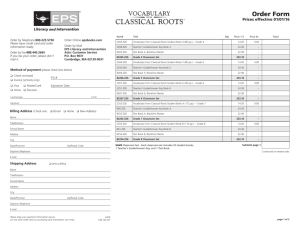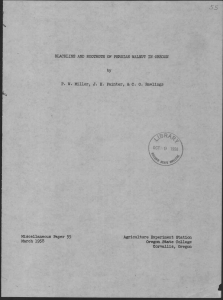cOf WALNU 0LACKLINE- Is April 1958
advertisement

V. II OREGON STATE LPJ( Docurnnts S'ci;n 'i.958 APR 14 195B 0LACKLINECOLLECTION cOf WALNU Is Extension Circular 644 April 1958 Cooperative Federal Extension Service Oregon State College Corvallis Cooperative Extension work in Agriculture and Home Economics, F. E. Price, director, Oregon State College and the United States Department of Agriculture cooperating. Printed and distributed in furtherance of Acts of Congress of May 8 and June 30, 1914. Blackline of Walnuts Blackline is a major disorder of grafted walnut trees in Oregon. It causes greater loss of trees than all other walnut diseases combined. Symptoms Blackline rarely develops in trees less than 10 years of age and is most common in 15- to 25-year-old trees. The first symptoms of blackline are weak growth, sparse foliage, yellowing and premature dropping of leaves from certain branches; death of the affected branches follows (Figure 1). Later, as the disorder progresses, additional branches on the same side of the tree die and finally the entire tree top dies. Failure of the newly formed wood (xylem) of the walnut top to unite with the wood the branches (Figure 2). A dark-brown or black layer of cork-like tissue forms between the xylem of the rootstock and the scion (Figure 3,A). At first, this layer is very narrow, but later it may become as much as one-fourth of an inch wide. In the beginning, only a sector of the trunk at the union may be involved, but in subsequent years the blackline gradually girdles the tree. Trees affected with blackline have had an apparently perfect union between the rootstock and scion for many years before the onset of the trouble. Then girdling occurs in the new wood; the wood formed previously is not affected (Figure 3,B). After blackline becomes well established, decay of the bark of the black walnut rootstock frequently occurs immediately beneath of the black walnut rootstock at the graft that part of the graft union affected by blackline. Affected trees usually die within four to six years after symptoms are first noted, but union causes girdling and subsequent death of sonic trees live longer. Figure 1 The early stage of blackline in a Franquette walnut tree grafted on J. hiridsii rootstock; note dead limbs on left side of tree. Figure 2 Advanced stage of blackline in a Franquette walnut tree grafted on J. hindsii rootstock; note dead top and suckers coming from root below the union. A Figure 3 Blackline of Persian walnut: A, tangential section through the graft union showing girdle (blackline) at the graft union; B, radial section through graft union showing the separation of the phloem and xylem, of recent origin, of the scion from that of the rootstock; a, Persian walnut scion; b, black walnut rootstock. Cause and nature of the disorder Blackline is believed to be a non-parasitic disorder. Its exact cause is not known. has been found in Oregon only on Persian walnut trees grafted on black walnut rootstocks, Juglans hindsii or J. nigra, or on hybrids of these species, or hybrids of Persian and black walnut. It has not been found in Persian walnut trees grafted on Persian walnut rootstocks (J. regia). Blackline is more prevalent in trees of the Franquette variety grafted on Hinds black walnut rootstocks than i trees of the Mayette variety on the same rootstocks. Blackline occurs in trees growing in many different soil types. It is generally more prevalent, however, in orchards on the heavier, upland soils, such as Olympic, than in those on the lighter, deeper, riverbottom types, such as Chehalis and Newberg. Trees lacking in vigor appear to be especially subject to blackline. The disorder starts at an earlier age and progresses more rapidly than on vigorous trees. Control A tree affected with blackline cannot be cured. Attempts have been made to overcome the effects of blackline by bridge- and marchgrafting, but such methods have not been successful in a practical way. The only known preventive measure is to plant trees of Persian walnut varieties that have been grafted on Persian walnut rootstocks. The more vigorous types of Persian seedlings, such as Manregian, should be used for the rootstocks. See eoeøa eete ,49ete j -o.e 4ze .dee4de4 4#td 4t4ece be4ed This circular was prepared by P. W. Miller, Plant Pathologist, Crops Research Division, Agricultural Research Service, U. S. Department of Agriculture, and I. C. MacSwan and C. 0. Rawlings, Extension Plant Pathology Specialist and Extension Horticulturist, respectively, Oregon State College.




